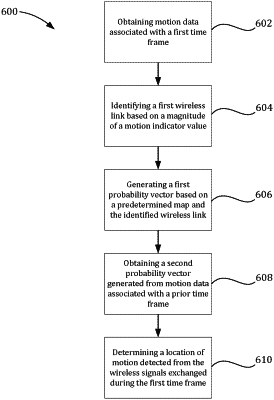| CPC G06N 7/01 (2023.01) [G06F 17/16 (2013.01); H04W 4/027 (2013.01); H04W 84/18 (2013.01)] | 30 Claims |

|
1. A method comprising:
obtaining motion data associated with a first time frame, the motion data comprising a set of motion indicator values indicating motion detected from wireless signals exchanged during the first time frame on a plurality of wireless links in a wireless communication network, each of the wireless links defined between a respective pair of wireless communication devices in the wireless communication network, each of the motion indicator values associated with a respective wireless link;
identifying a first wireless link, of the plurality of wireless links, based on a magnitude of a motion indicator value associated with the first wireless link relative to other motion indicator values in the set of motion indicator values;
generating a first probability vector based on a predetermined map and the first wireless link, the first probability vector comprising first values assigned to the respective wireless communication devices, the first values representing first probabilities of motion at the respective wireless communication devices during the first time frame;
obtaining a second probability vector generated from motion data associated with a prior time frame, the second probability vector comprising second values assigned to the respective wireless communication devices, the second values representing prior probabilities of motion at the respective wireless communication devices during the prior time frame; and
determining, by operation of a data processing apparatus, a location of the motion detected from the wireless signals exchanged during the first time frame, the location determined based on the second probability vector and the first probability vector.
|